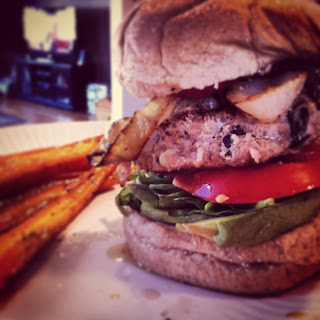It's green, sometimes mushy, depending on how it's cooked, smelly, and many might think yucky. What vegetable am I talking about? BROCCOLI! Now, I love cooked broccoli and always have. Fresh broccoli on the other hand, is a bit too "nature-tasting" for me. You or your children may think this as well, or you might not like broccoli prepared in any form. Once I tell you all the amazing health benefits of this lean, green, cancer-fighting machine, you'll be eating it everyday.
ALL THE GOOD STUFF
Even though broccoli can be a little scary looking with it's green color, it is known as one of the most nutrient dense vegetables in the produce section.
When you think of vitamin C, an orange probably pops into your head. Well guess what, broccoli has MORE vitamin C per ounce than an orange. When you think of calcium, you probably start to crave a cold glass of milk. Think again. Broccoli actually has just as much calcium as milk per ounce. Crazy, right?! Incorporating broccoli into you or your child's diet is an easy way to help increase the immune system with vitamin C if you our your child isn't fond of oranges or citrus fruits. If you or your child are one of those "people" who has never liked milk, or maybe are lactose intolerant, try eating more broccoli to compensate for the lack of calcium in your diet.
Broccoli isn't just a great source of vitamin C and calcium, this cruciferous vegetable is loaded with beta carotene, folate, protein, iron, potassium, tons of fiber, and best of all, cancer-fighting agents called glucosinolates.
CANCER-FIGHTING MACHINE
If your kids don't like broccoli tell them that broccoli has magical powers that help keep you from getting sick! I know, a little scary, but it could work. Broccoli really does lower the risk of cancers. The Academy of Nutrition and Dietetics found that "Evidence suggests foods high in dietary fiber, vitamins, minerals and phytonutrients can protect against some cancers." Broccoli fits right in with this description. How broccoli helps is by preventing the action of hormones that help stimulate the growth of tumors. Broccoli is also high in the bioflavonoid quercetin which helps to decrease cell damage and mutation. So start eating more broccoli so you can help yourself and your children stay healthy.
HOLY FIBER!
Vegetables, particularly green vegetables, are known for their high amounts of fiber. Broccoli contains 3.5 gm of fiber in 1 cup of cooked broccoli. Not only is it high in fiber, but broccoli also contains a natural laxative that will help ease constipation and get things moving along in the G.I. tract (gastrointestinal tract).
COOKING BROCCOLI
As I said before, I love broccoli, but only when cooked. One thing to watch out for when preparing broccoli is avoiding over cooking it. If over cooked, smelly sulfur compounds will definitely prevent your children from wanting to finish all their broccoli on their plate. If boiling broccoli, try to avoid using a lot of water. This will destroy the magical cancer-fighting compounds as well as vitamin C and other nutrients. When boiled or steamed, broccoli should be bright green, making it much more appealing to consume.
I encourage you to grow broccoli in your own backyard garden so you can have the freshest, most nutrient dense broccoli there is. When purchasing produce from your local grocery store, the produce has lost some of it's freshness just through travel and shelf time. If you can't grow your own broccoli, I recommend buying fresh if you know you are going to cook or eat it soon, but if you don't know when you will have time to prepare it, go ahead and buy frozen steamers. I'm a big fan of frozen vegetables, specifically steamers, because the vegetables are frozen at their peak freshness, ensuring a nutrient dense and fresh-tasting product, where as everyday that passes from harvesting, the produce item looses nutrients and freshness. Buying frozen not only gives you freshness as if it were picked that day, but also convenience.
RECIPE
Here's a link to a yummy (RAW) broccoli slaw.
SOURCES
Foods That Harm, Foods That Heal. Pleasantville, NY.: Reader's Digest, 2004. Print.
http://www.eatright.org/Public/content.aspx?id=6442472299


.JPG)













.JPG)
